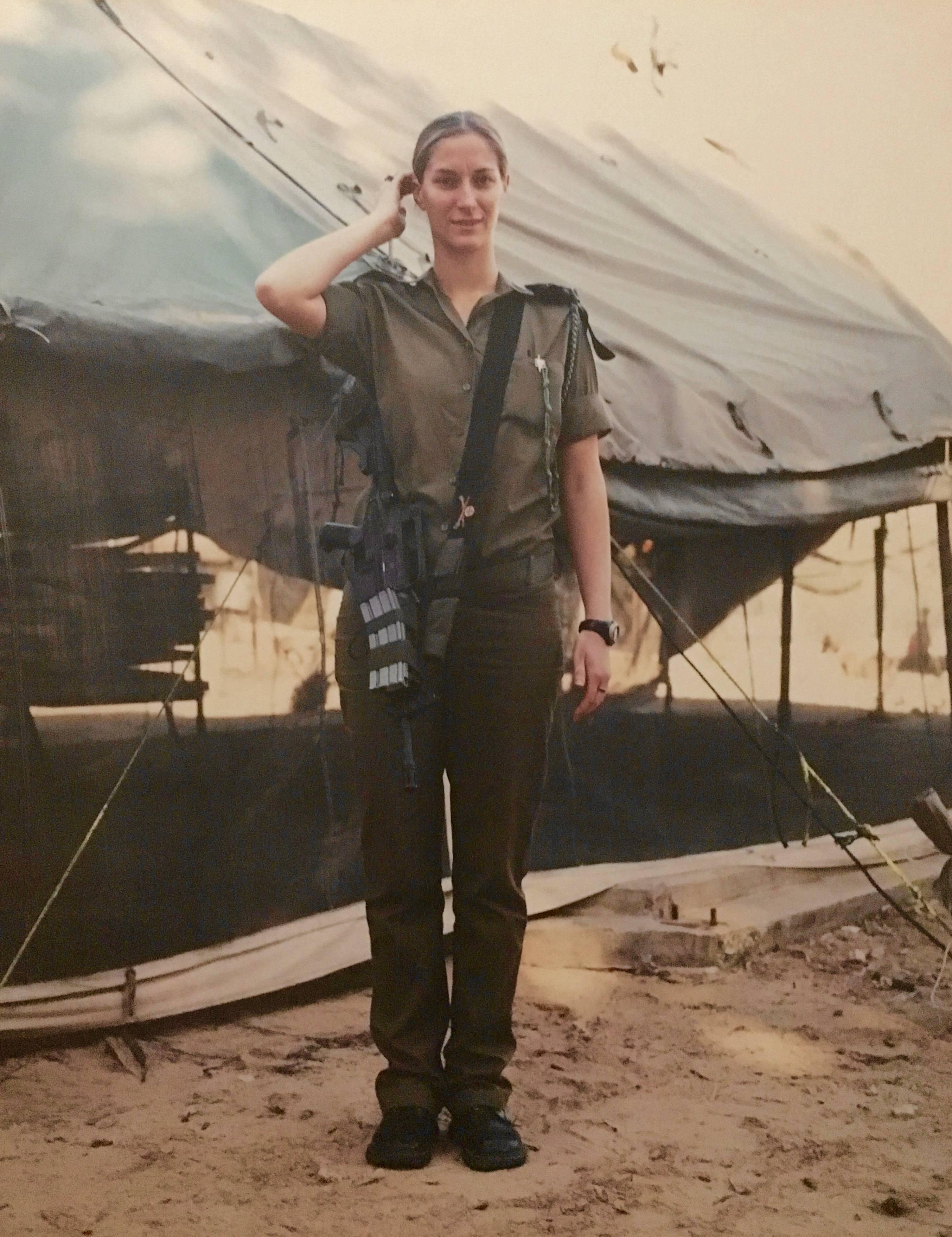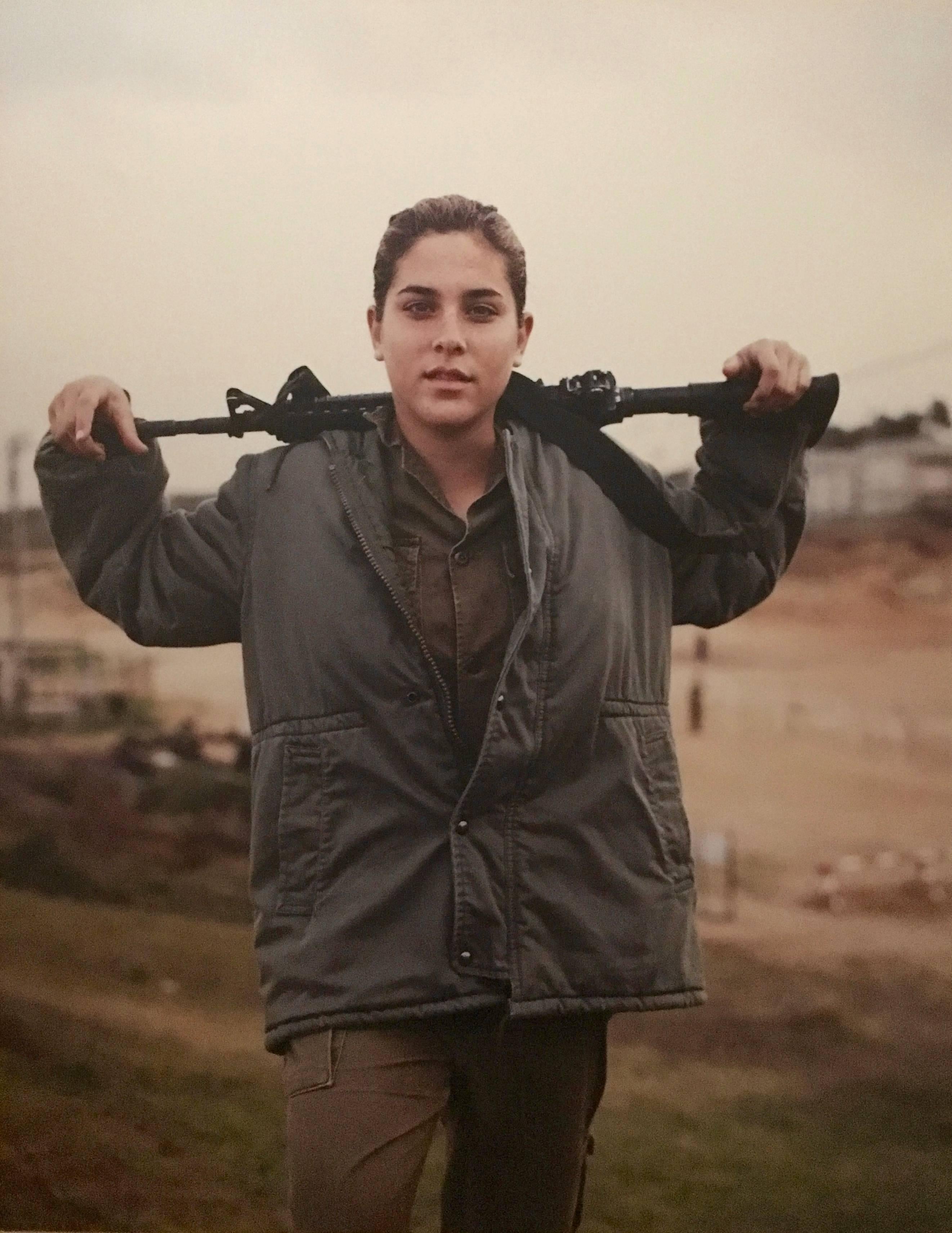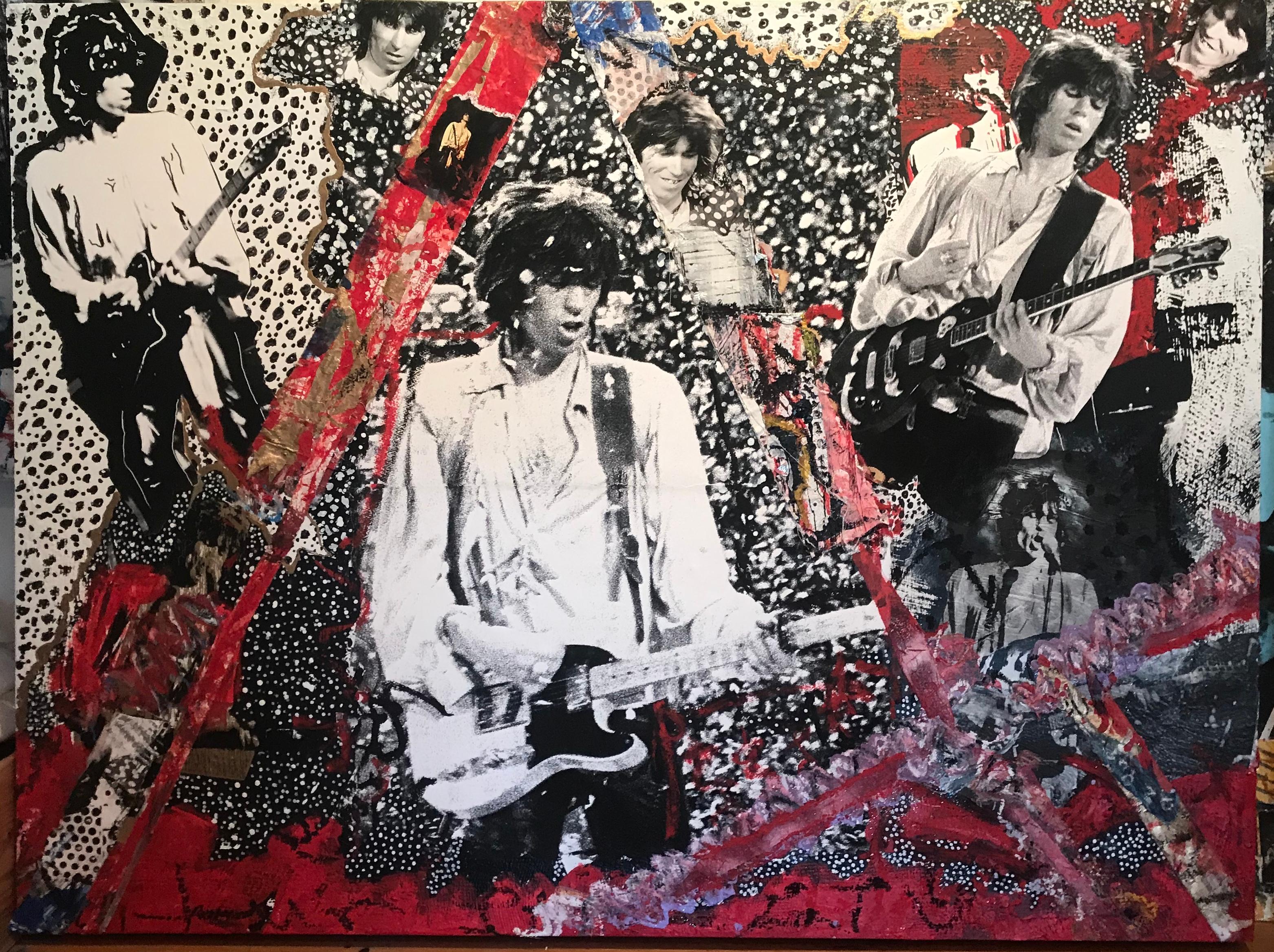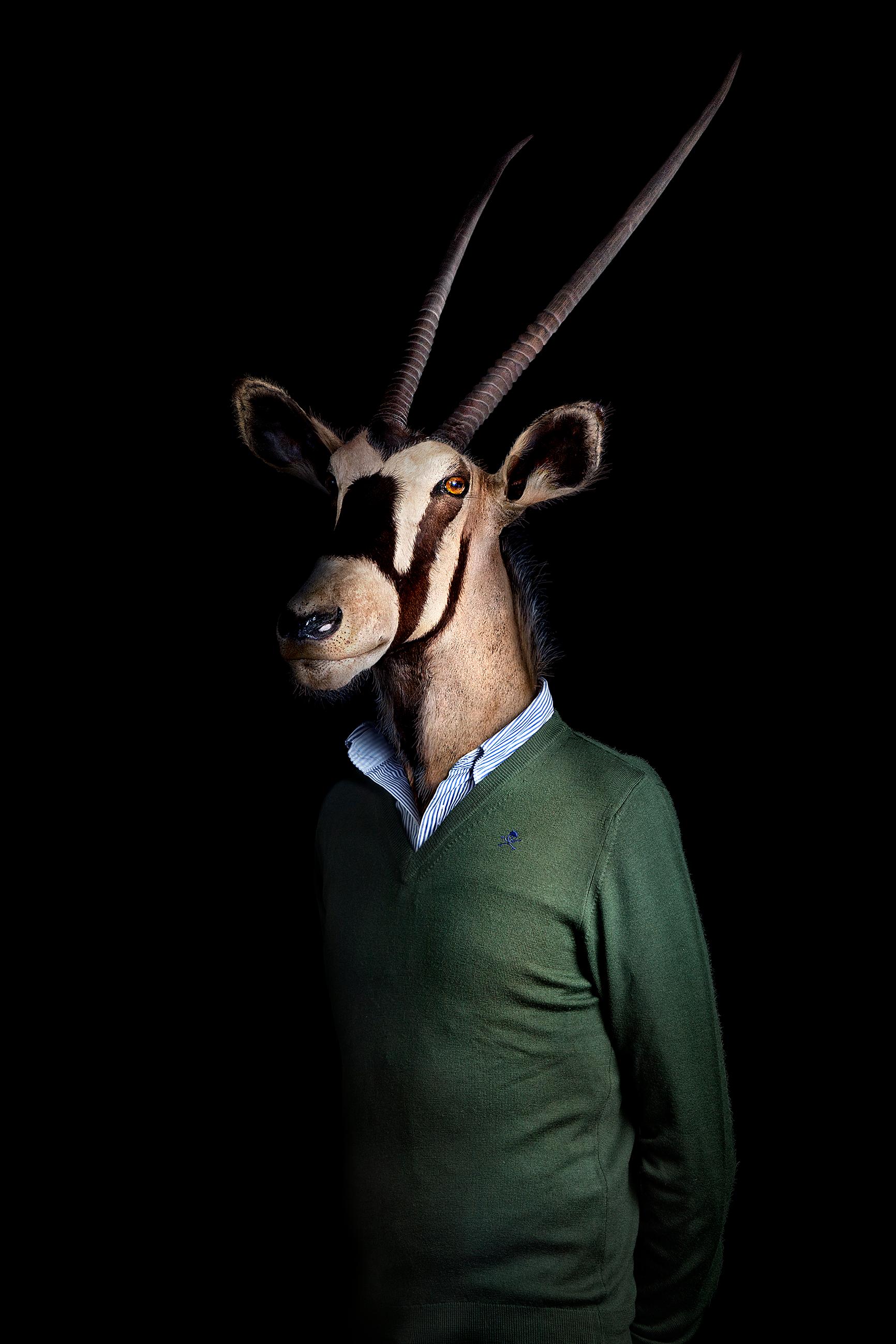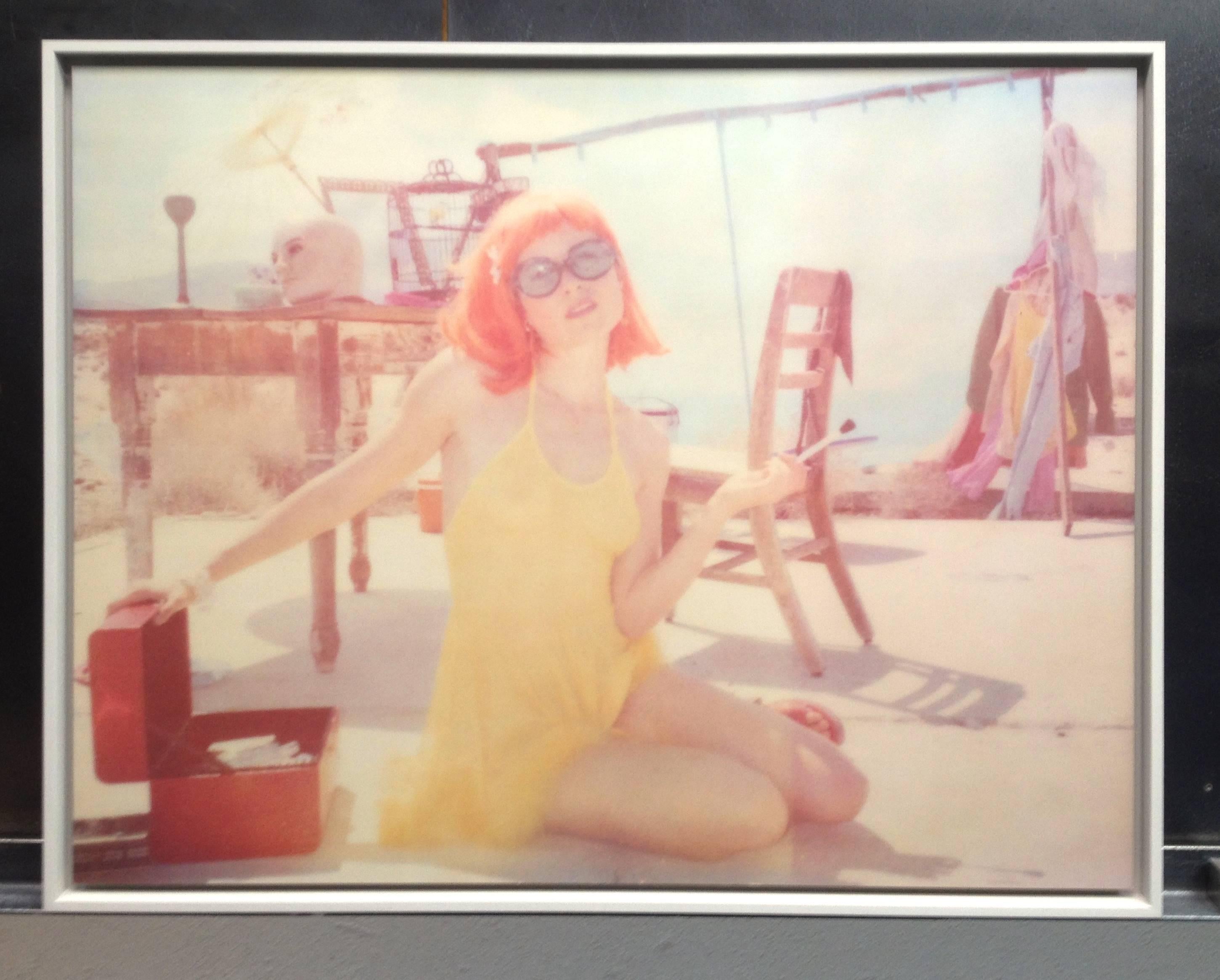Items Similar to Large Color Photograph "Women of the IDF" Ashkan Sahihi
Want more images or videos?
Request additional images or videos from the seller
1 of 8
Ashkan SahihiLarge Color Photograph "Women of the IDF" Ashkan Sahihi
About the Item
"Women of the IDF" Large Exhibition color Photograph
30 x 40 inches, mounted on masonite and laminated.
Edition of 4 + 2 artists proof. minor dings and bumps to edges Born in Tehran, Iran, Ashkan Sahihi moved with his family to West Germany at the age of seven. Although he began taking photographs as a teenager, Sahihi traces the beginning of his professional trajectory to New York in 1987, a thriving “pop culture metropolis” where he could do the kind of photography work that he wanted to do, exploring the underbelly of the society around him. Taking assignments from German publications such as the Süddeutsche Zeitung Magazine, Der Spiegel, Dummy and GEO, he photographed subjects like prisoners on death row, players in the hip-hop scene, and the downtown art scene of New York. Neither black nor white, an insider among outsiders, he found himself able to navigate spaces and dynamics that others might have had difficulty entering. He considered this both a privilege and an obligation – to visit these places and tell these stories. His success led to commissions from American publications as well, including the New York Times Magazine, the New Yorker, Rolling Stone, and Vogue.
Put off by the limitations of photojournalism (the expectation that he would illustrate the writer’s perspective rather than author a narrative of his own), Sahihi began to embark on independent, highly compact conceptual series. His main goal in these series has been to drive forward public discourse on topics he believes have not provoked enough or the right kind of discussion: drugs, gender in the media, women in the military, etc. His portraits draw on a familiar visual language – often seated subjects before a neutral backdrop – but push the viewer to feel and think about entirely new things. Although he constantly challenges the comfort level of both the viewer and the subject, Sahihi never removes himself from the line of fire; all of his work requires the artist to immerse himself in uncomfortable situations and challenge his own emotional fortitude.
Photographic Series
In the “Face Series”, latex-gloved hands manipulate the subjects’ features, stretching, pushing, squeezing, pinching at the whim of external direction – from the artist? The customer? The public? The “Hypnosis Series” comprises 8 portraits of hypnotized subjects each experiencing a single emotion, e.g. helplessness, withholding/anger, or regret. In a society that rewards the suppression of such naked emotion, the purity of these depictions is arresting.
In 2006, Sahihi photographed himself in the homes and with the families of six ex-girlfriends and one ex-wife, imposing himself more or less awkwardly on the constellations that emerged after he had exited their lives (“Exes Series”).
For Sahihi’s most well-known work, the “Drug Series,” he convinced 11 non–drug users to consume a particular drug, then took their portraits over the course of their trips. The series was born out of Sahihi’s frustration with the hypocrisy of the political conversation about drugs in the United States. “By attempting to present an objective image of drug use, the artist addresses the cultural politics that allow our society to simultaneously glamorize the ‘drug look’ in fashion magazines and the entertainment industry and meanwhile turn a blind eye to the complicated, and vast, problem of drug abuse.” Sahihi has exhibited this series at MoMA PS1 New York in 2001, in Dresden in 2008, and alongside his installation “100 Million in Ready Cash."
Sahihi’s dense explorations through small photographic series include “Women of the IDF," portraits of female Israeli soldiers; “Camp X-Ray Guantanamo Bay,” black-and-white landscapes of barbed wire and watch towers; the “Cum Series”; the “Armpit Series”; and the “Kiss Series," in which the artist photographed himself kissing 18 women and men of various ethnicities. Sahihi’s photographs of the Occupy Wall Street movement constitute his latest series of this kind.
In recent years, Sahihi has lived and worked in New York, Istanbul, the Middle East, and London, producing bodies of work in each place that attempt to engage the political discourse he deems lacking in substance.
Exhibitions
Andrea Rosen Gallery, NY, USA (2000)
Basel Art Fair 31, Switzerland (2000)
MoMA PS1, NY, USA (solo and group shows, 2001 and 2006)
John Connelly Presents, NY, USA
Akureyri Museum, Iceland
Akademie der Künste, Berlin, Germany
Axel Raben Gallery, NY, USA
Macro, Rome, Italy
Schloss Morsbroich, Leverkusen, Germany
Städtische Galerie, Dresden, Germany
Galerie am Körnerpark, Berlin, Germany (2015)
Galerie Springer, Berlin, Germany (2015)
Kehrer Galerie, Berlin, Germany (2016)
- Creator:Ashkan Sahihi (1963, Iranian)
- Dimensions:Height: 40 in (101.6 cm)Width: 31 in (78.74 cm)Depth: 1 in (2.54 cm)
- Medium:Laminate,Masonite
- Period:
- Condition:minor bumps and dings to edges.
- Gallery Location:Surfside, FL
- Reference Number:1stDibs: LU38211197342
About the Seller
4.9
Platinum Seller
These expertly vetted sellers are 1stDibs' most experienced sellers and are rated highest by our customers.
Established in 1995
1stDibs seller since 2014
1,546 sales on 1stDibs
Typical response time: 1 hour
- ShippingRetrieving quote...Ships From: Surfside, FL
- Return PolicyA return for this item may be initiated within 3 days of delivery.
More From This SellerView All
- WOMEN OF THE ISRAEL DEFENSE FORCES Large Photo NETABy Ashkan SahihiLocated in Surfside, FL"Women of the IDF" Large Exhibition color Photograph 30 x 40 inches, mounted on masonite and laminated. Edition of 4 + 2 artists proof. minor dings and bumps to edges Born in Tehran, Iran, Ashkan Sahihi moved with his family to West Germany at the age of seven. Although he began taking photographs as a teenager, Sahihi traces the beginning of his professional trajectory to New York in 1987, a thriving “pop culture metropolis” where he could do the kind of photography work that he wanted to do, exploring the underbelly of the society around him. Taking assignments from German publications such as the Süddeutsche Zeitung Magazine, Der Spiegel, Dummy and GEO, he photographed subjects like prisoners on death row, players in the hip-hop scene, and the downtown art scene of New York. Neither black nor white, an insider among outsiders, he found himself able to navigate spaces and dynamics that others might have had difficulty entering. He considered this both a privilege and an obligation – to visit these places and tell these stories. His success led to commissions from American publications as well, including the New York Times Magazine, the New Yorker, Rolling Stone, and Vogue. Put off by the limitations of photojournalism (the expectation that he would illustrate the writer’s perspective rather than author a narrative of his own), Sahihi began to embark on independent, highly compact conceptual series. His main goal in these series has been to drive forward public discourse on topics he believes have not provoked enough or the right kind of discussion: drugs, gender in the media, women in the military, etc. His portraits draw on a familiar visual language – often seated subjects before a neutral backdrop – but push the viewer to feel and think about entirely new things. Although he constantly challenges the comfort level of both the viewer and the subject, Sahihi never removes himself from the line of fire; all of his work requires the artist to immerse himself in uncomfortable situations and challenge his own emotional fortitude. Photographic Series In the “Face Series”, latex-gloved hands manipulate the subjects’ features, stretching, pushing, squeezing, pinching at the whim of external direction – from the artist? The customer? The public? The “Hypnosis Series” comprises 8 portraits of hypnotized subjects each experiencing a single emotion, e.g. helplessness, withholding/anger, or regret. In a society that rewards the suppression of such naked emotion, the purity of these depictions is arresting. In 2006, Sahihi photographed himself in the homes and with the families of six ex-girlfriends and one ex-wife, imposing himself more or less awkwardly on the constellations that emerged after he had exited their lives (“Exes Series”). For Sahihi’s most well-known work, the “Drug Series,” he convinced 11 non–drug users to consume a particular drug, then took their portraits over the course of their trips. The series was born out of Sahihi’s frustration with the hypocrisy of the political conversation about drugs in the United States. “By attempting to present an objective image of drug use, the artist addresses the cultural politics that allow our society to simultaneously glamorize the ‘drug look’ in fashion magazines and the entertainment industry and meanwhile turn a blind eye to the complicated, and vast, problem of drug abuse.” Sahihi has exhibited this series at MoMA PS1 New York in 2001, in Dresden in 2008, and alongside his installation “100 Million in Ready Cash." Sahihi’s dense explorations through small photographic series include “Women of the IDF," portraits of female Israeli soldiers...Category
Early 2000s Portrait Photography
MaterialsMasonite
- WOMEN OF THE IDF Large color Photograph LITALBy Ashkan SahihiLocated in Surfside, FL"Women of the IDF" Large Exhibition color Photograph 30 x 40 inches, mounted on masonite and laminated. Edition of 4 + 2 artists proof. minor dings and bumps to edges Born in Tehran, Iran, Ashkan Sahihi moved with his family to West Germany at the age of seven. Although he began taking photographs as a teenager, Sahihi traces the beginning of his professional trajectory to New York in 1987, a thriving “pop culture metropolis” where he could do the kind of photography work that he wanted to do, exploring the underbelly of the society around him. Taking assignments from German publications such as the Süddeutsche Zeitung Magazine, Der Spiegel, Dummy and GEO, he photographed subjects like prisoners on death row, players in the hip-hop scene, and the downtown art scene of New York. Neither black nor white, an insider among outsiders, he found himself able to navigate spaces and dynamics that others might have had difficulty entering. He considered this both a privilege and an obligation – to visit these places and tell these stories. His success led to commissions from American publications as well, including the New York Times Magazine, the New Yorker, Rolling Stone, and Vogue. Put off by the limitations of photojournalism (the expectation that he would illustrate the writer’s perspective rather than author a narrative of his own), Sahihi began to embark on independent, highly compact conceptual series. His main goal in these series has been to drive forward public discourse on topics he believes have not provoked enough or the right kind of discussion: drugs, gender in the media, women in the military, etc. His portraits draw on a familiar visual language – often seated subjects before a neutral backdrop – but push the viewer to feel and think about entirely new things. Although he constantly challenges the comfort level of both the viewer and the subject, Sahihi never removes himself from the line of fire; all of his work requires the artist to immerse himself in uncomfortable situations and challenge his own emotional fortitude. Photographic Series In the “Face Series”, latex-gloved hands manipulate the subjects’ features, stretching, pushing, squeezing, pinching at the whim of external direction – from the artist? The customer? The public? The “Hypnosis Series” comprises 8 portraits of hypnotized subjects each experiencing a single emotion, e.g. helplessness, withholding/anger, or regret. In a society that rewards the suppression of such naked emotion, the purity of these depictions is arresting. In 2006, Sahihi photographed himself in the homes and with the families of six ex-girlfriends and one ex-wife, imposing himself more or less awkwardly on the constellations that emerged after he had exited their lives (“Exes Series”). For Sahihi’s most well-known work, the “Drug Series,” he convinced 11 non–drug users to consume a particular drug, then took their portraits over the course of their trips. The series was born out of Sahihi’s frustration with the hypocrisy of the political conversation about drugs in the United States. “By attempting to present an objective image of drug use, the artist addresses the cultural politics that allow our society to simultaneously glamorize the ‘drug look’ in fashion magazines and the entertainment industry and meanwhile turn a blind eye to the complicated, and vast, problem of drug abuse.” Sahihi has exhibited this series at MoMA PS1 New York in 2001, in Dresden in 2008, and alongside his installation “100 Million in Ready Cash." Sahihi’s dense explorations through small photographic series include “Women of the IDF," portraits of female Israeli soldiers...Category
Early 2000s Portrait Photography
MaterialsMasonite
- Vintage Silver Gelatin Print Photograph Gary Cooper, His Last Photo, SignedLocated in Surfside, FLThis is a vintage black and white photograph (shot in 1961 and printed in 1975) of famed actor Gary Cooper by internationally renowned PhotographerSherman Weisburd. This Vintage photograph was developed from the original negative and is the last portrait photo taken before his death. This photo was selected as a possible cover for Good Housekeeping Magazine. It is hand signed in marker, lower right by Sherman Weisburd. Sherman Weisburd, known for his album cover photos of the 1960s and '70s and advertising work of the early '70s. Photographer for Playboy Magazine, TV Guide (Sonny & Cher), and Viva Magazine. Grammy nominated for his photo of Charles Aznavour, He shot Arlo Guthrie for the cover of Alice's Restaurant, Betty Ford for Ingenue magazine, Marilyn Monroe for Modern Screen magazine. He also shot Ashford & Simpson and was a cinematographer for Universal and Paramount pictures. Gary Cooper was an Oscar winning American actor. A major movie star from the end of the silent film era through to the end of the golden age of Classical Hollywood. Throughout his career, he sustained a screen persona that represented the ideal American hero. In the early 1930s, he expanded his heroic image to include more cautious characters in adventure films and dramas such as A Farewell to Arms (1932) and The Lives of a Bengal Lancer (1935). During the height of his career, Cooper portrayed a new type of hero—a champion of the common man—in films such as Mr. Deeds Goes to Town (1936), Meet John Doe (1941), Sergeant York (1941), The Pride of the Yankees (1942), and For Whom the Bell Tolls (1943). In the postwar years, he portrayed more mature characters at odds with the world in films such as The Fountainhead (1949) and High Noon (1952). In his final films, Cooper played non-violent characters searching for redemption in films such as Friendly Persuasion (1956) and Man of the West (1958). Cooper had a series of romantic relationships with leading actresses, beginning in 1927 with Clara Bow, who advanced his career by helping him get one of his first leading roles in Children of Divorce In 1929, while filming The Wolf Song, Cooper began an intense affair with Lupe Vélez...Category
1960s American Modern Portrait Photography
MaterialsSilver Gelatin
- Vintage Silver Gelatin Photograph Print, Girls on a Beach Photo, Two Man ShowLocated in Surfside, FLRichard Lebowitz, b. 1937, American, (RISD Faculty 1964-1995, Photography; Professor Emeritus) Tom Young, b. 1951, American, (RISD MFA 1977, Photography) TIT...Category
1980s American Modern Black and White Photography
MaterialsPhotographic Paper, Silver Gelatin
- Faces, Vintage Color Photograph Digital Photo Collage Print Asian AmericanBy Emily ChengLocated in Surfside, FLThis was from Muse X publishers. It came in a plastic bag signed Emily Cheng. (the plastic bag is not included) It is on Fuji crystal photo paper. It depicts two Asian faces in a cubist, fractured way, with a woman (or man) holding a photograph over his/her face. It is a proof print and is not signed or numbered. Emily Cheng (born in New York City, in 1953) is an American artist of Chinese ancestry. She is best known for large scale painting with a center focus often employing expansive circular images radiantly colored, radially composed. Cheng received her BFA in 1975 from the Rhode Island School of Design and attended the New York Studio School. Cheng has exhibited widely in the US and in Asia. In 2011, Cheng created Charting Sacred Territories, an exhibition exploring world religions which opened in the Museum of Contemporary Art Taipei (MOCA) , Taiwan (2011) and traveled to Hanart TZ Gallery in (2015), Shenzhen Art Museum, Shenzhen, China, (2015) and in Europe at the Palais Liechtenstein Feldkirch, Austria (2019). Cheng has had numerous solo shows in the US and in Asia and is represented by Hanart TZ Gallery in Hong Kong. In 2007, Timezone 8 published a monograph of Emily Cheng titled, Chasing Clouds, a decade of studies, with essays by Kevin Powers and Johnson Chang. Emily Cheng has lived and worked in New York City since 1977 and teaches Asian Art History at the School of Visual Arts. Influenced by a wide array of eastern and western artists including Van Gogh, Gauguin, Manet and Giacometti as well as de Kooning, early Philip Guston and Jackson Pollock. Nicolas Carone and Leland Bell were both among her teachers as well as Elaine de Kooning. Selected solo exhibitions Ille Arts, Amagansett, New York, Shenzhen Art Museum, Shenzhen, China, (2015) Hanart T.Z. Gallery, Hong Kong, Zane Bennett Contemporary, Santa Fe, New Mexico, (2013) Museum of Contemporary Art (MOCA) Taipei , Taiwan (2011) Louis Vuitton Maison, Kowloon, Hong Kong, (2010) Ayala Museum Makati, Philippines, (2006) Plum Blossom Gallery, New York, NY, (2004) Schmidt/Dean Gallery, Philadelphia, PA Byron Cohen Gallery, Kansas City, MO (2001) Metropolitan Museum of Manila , Philippines (1997) John Post Lee Gallery, New York, NY, Projects Room (1997) Contemporary Arts Center , Cincinnati, Ohio, 1994 David Beitzel Gallery, New York, NY, (1992) Lang & O'Hara Gallery, New York, NY, The Bronx Museum of the Arts , Bronx, NY, (1989) White Columns , New York, NY, (1985) Selected group exhibitions Art Basel Hong Kong , (Hanart Gallery) , Hong Kong, 2017 China Institute, New York, NY, 2014 Beijing Art Fair, Beijing, China, 2013 Museum of Chinese in America New York, NY, 2010 Kidspace, MASS MoCA , Williamstown, MA, 2010, 2005 Museum of Contemporary Art , Shanghai, China, 2009 Guangzhou Triennial, Guangdong, China, 2009 Museum of Art, Guangzhou, China, 2008 Contrast Gallery, Shanghai and Beijing, China, 2008 University of South Florida Contemporary Art Museum , Tampa, Florida, 2006 Hong Kong Arts Centre , Hong Kong, 2004 American Academy of Art , New York, New York, 2004 Longmarch Project, Beijing, China, 2002 Sotheby’s , New York, NY, 2001 Newhouse Center, Snug Harbor Cultural Center, Staten Island, NY, 2000 Katonah Museum of Art , Katonah, NY, 2000 National Academy and Museum, NY, 2000 Municipal Museum of Gyor, Hungary, 1999 New Museum of Contemporary Art , New York, NY, 1998 De Cordova Museum and the Computer Museum , Boston, MA, 1994 International Graphic Biennial, Muveszeti Museum, Hungary, 1995 Yerba Buena Center for the Arts , San Francisco, CA, 1994 Drawing Center, NY; traveled to Corcoran, Washington D.C., Santa Monica Museum of Art, Santa Monica CA; The Contemporary Art Museum St. Louis, St. Louis MO; American Center, Paris, France, Cone Editions Gallery, New York 1990 Anina Nosei Gallery, New York, 1988 Greenville County Museum of Art , South Carolina, 1988 North Carolina Museum of Art , Hallwalls , Buffalo, NY, 1988 Grace Borgenicht Gallery , New York, 1986 Tibor de Nagy, New York, 1985 Asian American...Category
1990s Conceptual Portrait Photography
MaterialsPhotographic Paper, C Print
- Faces, Vintage Color Photograph Digital Photo Collage Print Asian AmericanBy Emily ChengLocated in Surfside, FLThis was from Muse X publishers. It came in a plastic bag signed Emily Cheng. (the plastic bag is not included) It is on Fuji crystal photo paper. It depicts two Asian faces in a cub...Category
1990s Conceptual Portrait Photography
MaterialsPhotographic Paper, C Print
You May Also Like
- Keith Snow StormBy Steve JoesterLocated in New York, NYMixed Media on wood featuring the infamous Keith Richards. Photographed by Joester. About the Artist: Steve Joester is a British-born Rock & Roll photographer and mixed media a...Category
2010s Contemporary Figurative Paintings
MaterialsMasonite, Mixed Media, Photographic Film
- Second Skin Nº 23By Miguel VallinasLocated in Madrid, ESSecond Skin is the fist serie of Miguel Vallinas' surreal images that reconsider the human form. Second Skin explores the concept of identity and personal ...Category
2010s Contemporary Portrait Photography
MaterialsWood
- Captain Nelson (29 Palms, CA) - Contemporary, Polaroid, 21st Century, DreamBy Stefanie SchneiderLocated in Morongo Valley, CACaptain Nelson (29 Palms, CA) - 2007 37x49x3.5cm, Edition 1/5. Artist Inventory No 4033.01. Analog C-Print, Hand-printed by the artist, mounted on a wooden box with matte UV-Prot...Category
Early 2000s Contemporary Abstract Photography
MaterialsWood, Archival Paper, Photographic Paper, C Print, Color, Polaroid
- Treasure II (29 Palms, CA) - Polaroid, framed, analogBy Stefanie SchneiderLocated in Morongo Valley, CATreasure II (Stage of Consciousness) 29 Palms, CA, 2007, 75x93cm, Edition 3/5. Analog C-Print printed on Fuji Archive Paper, hand-printed by the artist, based on a Polaroid. Sign...Category
Early 2000s Contemporary Color Photography
MaterialsWood, Archival Paper, Photographic Paper, C Print, Color, Polaroid
- Camo & DotsBy Hassan HajjajLocated in Saint Louis, MOWith his multimedia portraits, Moroccan artist Hassan Hajjaj thrives in a space between cultures, traditions, mediums, and artistic movements. The subjects of his photography range f...Category
Early 2000s Portrait Photography
MaterialsLambda, Wood
- Done Crying (The Girl behind the White Picket Fence)By Stefanie SchneiderLocated in Morongo Valley, CADone Crying (The Girl Behind the White Picket Fence) - 2013 Edition 1/10, 48,7 x 50 cm (External dimensions: 53,1 x 54,4 cm) Archival C-Print, based on the Polaroid, mounted on Alu-...Category
2010s Contemporary Color Photography
MaterialsPhotographic Paper, Wood, Archival Paper, C Print, Color, Polaroid
Recently Viewed
View AllMore Ways To Browse
Womens Movement
Women 11
Gloves Large
Large Gloves
31 Women
Seated Women
Soldier Portraits
Portrait Of Soldier
Portrait Of A Soldier
Black Face Watch Mens
Israeli Women
Mens Watch With Black Face
Portrait Female Photograph Color
Small Womens Watch
Swiss Watch For Women
Swiss Watches For Women
Iceland Photograph
Dresden Large
